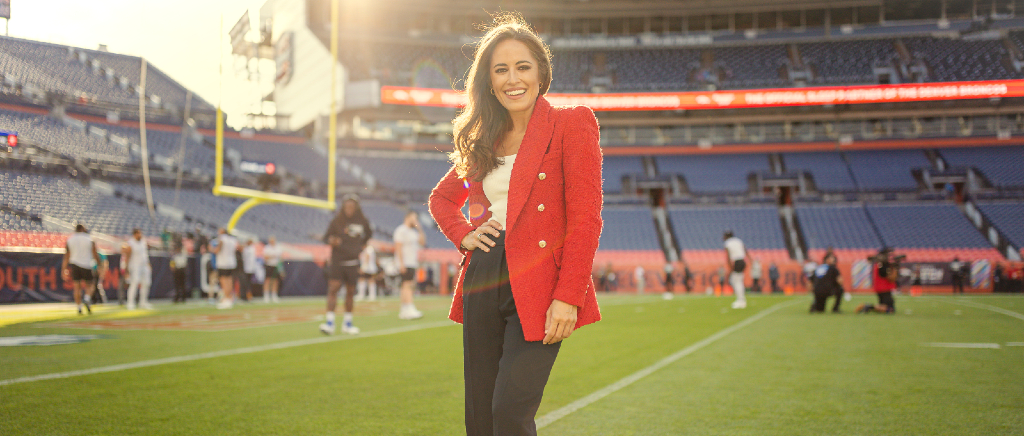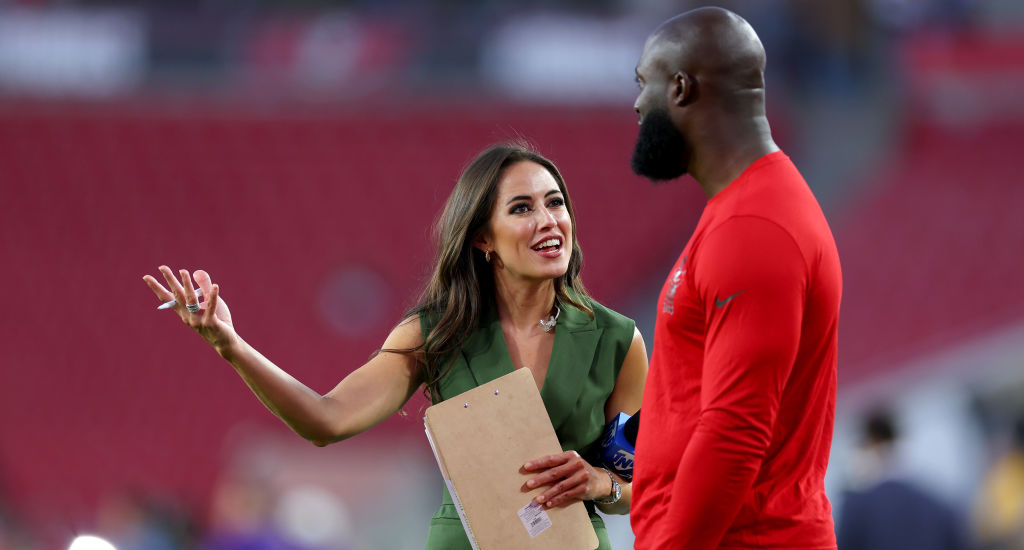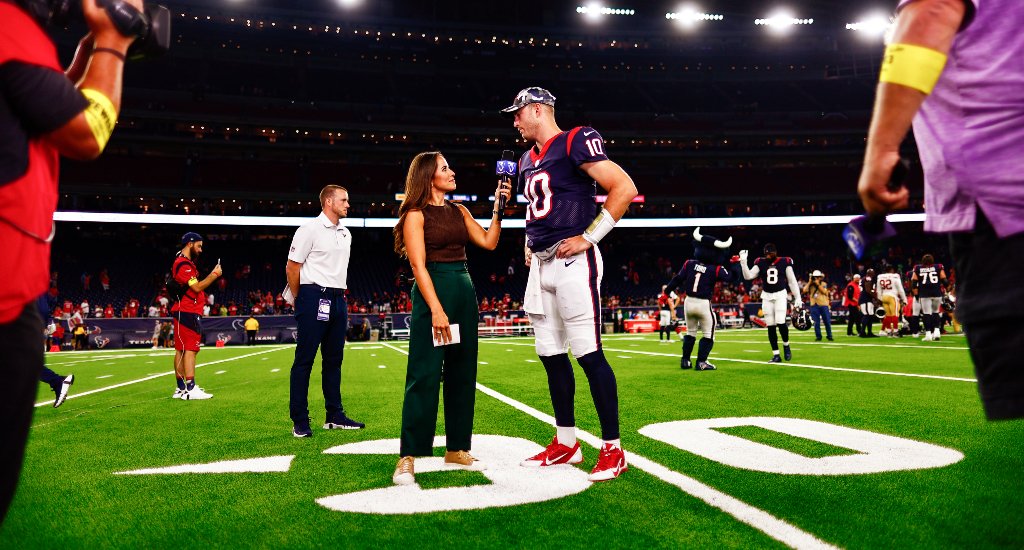
Many were surprised to see Kaylee Hartung filling the sideline reporter role when Amazon announced its broadcast team for Thursday Night Football this offseason.
Hartung, looking to broaden her horizons and continue her growth as a journalist and reporter, left ESPN for the news world — first CNN, then ABC News — five years ago. Few would have placed her on the shortlist for an NFL primetime broadcast. Among those few was Jared Stacy, Amazon’s Director of Global Live Sports Production, who suggested her to executive producer Fred Gaudelli as someone to consider for the position while Gaudelli was having a tough time finding the right fit.
“I look at that job as a real reporter. I don’t look at that job as a personality. I don’t look at that job as a a fluff position. Like, I want a real reporter and so that was definitely a plus in her column,” Gaudelli says. “I mean, she was not even on my radar. I really need to give credit to Jared Stacy here … he said, would you have a conversation with her? At that point, I didn’t have a lot of great ideas for sideline. And I said sure. So we had conversation on the phone, and then she actually came to my house in the middle of the winter. She flew across the country, and we spent a Saturday watching Michelle Tafoya tape. Her news background definitely was a plus for me. It’s a wide variety of experiences. It’s not doing the same thing every every day.”
For Hartung, the interest from Amazon came as just as much of a surprise, but the initial call was one she had to take and ultimately became an opportunity she couldn’t turn down.
“When you start off with Al Michaels is a part of the team, like, the word legend can be overused sometimes but he is truly a legend in our lifetimes,” Hartung says. “And then Fred Gaudelli, who has been Al’s producer for almost three decades. There’s no better teacher I can have leading this than Fred. And then Kirk [Herbstriet] was hired before anything was finalized with me and I’ve known him since the very beginning of my time at ESPN.
“So it was just like, how am I even being included in this conversation? It was just sort of a shock to me being five years removed from sideline reporting,” she continues. “I was so pleasantly surprised. But then, as conversations evolved, and the more I got to talk with Fred, he told me that his favorite thing about me was my news background. He treats the sideline reporter role seriously. And he believed that I would, too, and so I think there were just a lot of common values and common visions for what this role would look like. And here we are.”
While she had experience in college football, both Gaudelli and Hartung admit there was some trepidation about her never working in the NFL. It is a world all its own, with different politics and personalities to navigate than in the college game. But after their meeting in-person, Gaudelli felt confident that Hartung would quickly build the relationships with teams and players that are needed to gather information to enhance the broadcast.
“The fact that she had done college football and a lot of the players and even some of the coaches were now in the NFL, I just got from her very determined demeanor that she was going to make relationships and establish relationships that would allow her to get better at her job,” Gaudelli says. “And I will say she’s done that. She’s pretty darn good down there before the game, getting to meet people and trying to get information out of them. So, I’ve really, really enjoyed that part of working with her.”
That determination extends beyond the field, as Hartung immediately dug into her new role, trying to get up to speed as quickly as she could on what Gaudelli and Michaels would want. Michaels, in their first meeting, said he’d rely on her for “medical, legal, I’m counting on you for those details.” From there, it was diving into more tape of Tafoya, who worked with Michaels and Gaudelli at NBC and provided an example of the tone and structure they preferred, as well as insight into how Michaels works off of his sideline reporter.
“I went to one of our production assistants and said, ‘How much of Michelle’s tape can I get my hands on?’” Hartung says. “And they sent me the last five seasons of every report she’s done, and I’ve watched every one of those seasons more times than I can count. There were times — I feel like such a psycho when I say that — there were times I’ll be driving in my car, and I’ll just put on her tape just for me to listen to the way she’d structure a report, the way she would story tell, the way she would play off of Al and the way Al would play off her. There’s no worse feeling for a sideline reporter than being left on an island. But that’s a two way street, right? I’ve got to take the ball from Al in the way he’s talking to me, but I’ve also got to leave that door open for there to be runway for he and Kirk to build from. I hope that every report I do gives them an opportunity to continue down that path.”

The unique Thursday Night Football structure, which features new teams every week with very few repeats, can be a challenge for reporters as they start from scratch and can’t build out relationships over the course of the year in the same way other networks can. For Hartung, who was going to start from scratch regardless, it’s provided an opportunity for a speed run of sorts through the NFL, as she gets to lay a foundation with players, coaches, and executives from almost every team in her first year — the only teams not on Amazon’s schedule in 2022-23 are the Giants, Lions, and Vikings.
Seeing just about every team has also brought a bit of comfort to Hartung, because despite being five years removed from covering college football, she come across players she covered as stars in college who now star in the pros on a weekly basis. Those relationships still being there has helped alleviate her “biggest insecurity” about entering a new league and bolstered her confidence in returning to the sidelines. Along with seeing players she’s covered, the newest element to NFL broadcasts — the in-game coaching interview — helps Hartung build trust with coaches across the league.
As opposed to talking to coaches off camera as they go into and out of the locker room, broadcasts this year can do on-camera interviews between quarters if the coach agrees. For the reporters, it’s a rare chance to gather insight from the coaches during the game, but it requires a delicate balance to pry as much information out of the coaches as they can without pressing with questions a coach can’t or won’t answer and getting completely shut down. As Hartung has learned, the key is to get as granular as possible, noting that the coaches aren’t in a mindset to think big picture in the middle of the game. The best answers in those moments, particularly between the first and second or third and fourth quarters, come from being very specific and very focused on what’s happening in the game at that moment.
That belief was reinforced in Amazon’s preseason game between the 49ers and Texans, when Hartung spoke with Kyle Shanahan before the fourth quarter. Prior to the game, Shanahan had given fair warning that he might be a bit intense, telling her in their pre-game Zoom call, “Kaylee, I know we’ve never met, I swear I’m a nice guy. I want you to know I’m a nice guy, but during a game, I’m not nice. So, however I may behave during this interview, don’t take it personally. It’s not about you. I’m just focused on the game and I’m apologizing in advance.”
At that time, the dominant storyline in San Francisco was Trey Lance taking over the starting job so Hartung knew there had to be one Lance question, even if he hadn’t played since the first quarter. But the second question needed to be more in the moment, knowing that was Shanahan’s focus.
“I just said, ‘Coach, we haven’t seen your starters on the field in two quarters, but how do you put into perspective what this last quarter of preseason football means to the guys who are still on the field?’” Hartung recalls. “And I felt like that question did two things: It gave anybody who’s at home watching a reason to keep watching — here’s why you should watch the fourth quarter.
“But it also put Kyle in a position to talk about something I knew he cared to talk about,” she continues. “And he gave a great answer about how the guys who are on the field are fighting for their lives, and even if they’re not going to make our team, what they put on tape is their resume for the next team. Anyway, it was just a really a thoughtful and great answer and it was a great learning experience for me to think about how I approach those interviews, and to think about setting these guys up to tell us something interesting so that we all learn something, because that’s the point.”

Part of the allure of returning to sports for Hartung was getting back to a celebratory atmosphere. Her postgame interview is with a person having one of their best days, while on-the-ground reporting for ABC News often meant she was speaking to people having their worst.
Still, those serious subjects arise in covering the NFL, from on-field injuries like Tua Tagovailoa’s concussion in Cincinnati to an off-field story regarding legal issues. Her time in the news world helped her become a more well-rounded reporter, and she says she’s now much better positioned to handle those stories with the nuance and gravity they require.
“I think that sometimes in a sports broadcast, it all seems so fun and it seems so light, but we’ve had to tackle some heavy stories in moments,” Hartung notes. “In one of our preseason games with the Texans we were talking about their head athletic trainer, who’s from Uvalde, Texas, and who lost so many people he loved, and so many families he loved were affected by that tragedy. And that’s a story I’m able to tell with the right tone, no matter the moment. I know how to do that. I know how to make that transition, whereas I don’t know that six, seven years ago I would have been able to do that in the same way. But now, it’s almost harder for me to get back to being as casual and fun as I should be in some moments in a football game. I’ve had to kind of check myself and be like, you can have fun, you know what I mean? It’s okay, this is football.”
Hartung has steadily grown back into the sideline role, finding her footing once again within the pace of a football broadcast. She’s also been reminded of the frustrations of having information that can augment a conversation in the booth, only for the game to have a sudden change that shifts the discussion away before she can add to it. It is the hardest part of the job, as every sideline reporter can show you pages and pages of notes, anecdotes, and stories that have never made it into a game broadcast simply because you are at the mercy of the game.
Still, in gathering that information, Hartung’s process is always focused on trying to bring something new to those watching. Fans are consuming everything there is about their favorite team and have been their whole lives. As such, her job is to provide nuggets of information that you can only know by being on the field and having the opportunity to talk with the players and coaches.
“The challenge I’m always giving myself is, I can never know as much about these teams as their most fervent fans,” Hartung says. “The guys and gals who have lived and breathed these teams their whole lives and love them endlessly. Like, no matter how hard I prepare, I can’t know as much as they know.
“But what I can hope to do is to give them some bit of information that they can’t know because they don’t have the access that I do in that moment. I’m on the field, they’re on their couch. What can I tell them from my vantage point that can help them learn something?”
